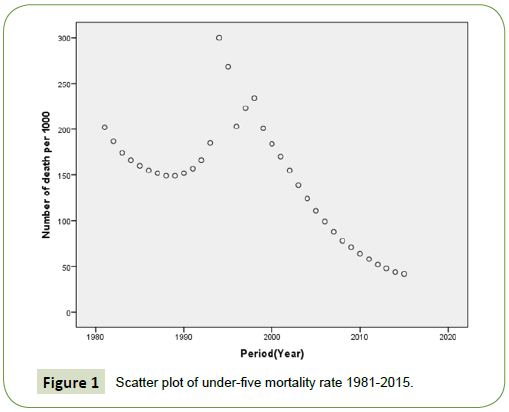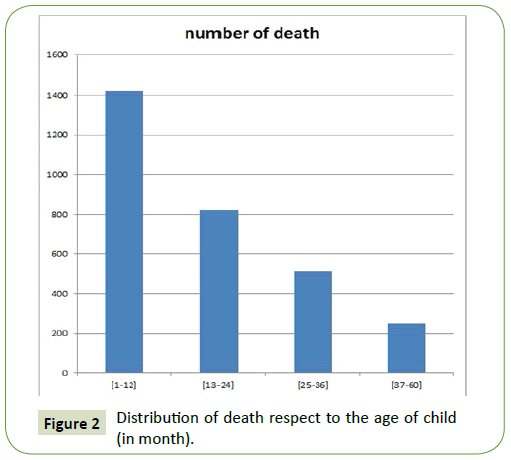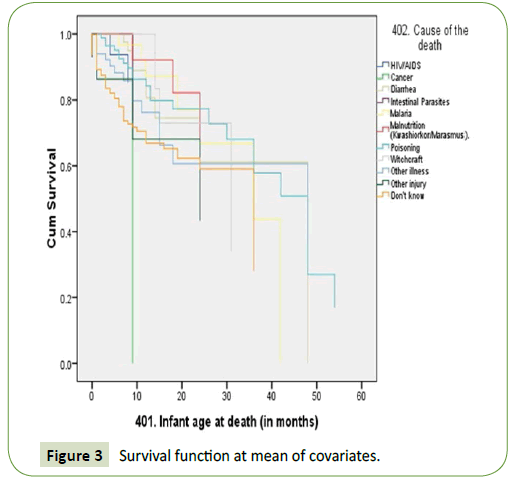An Empirical Analysis of Death of Children Under Five Years in Rwanda
Fidence Munyamahoro*
Department of Actuarial Sciences, University of Lausanne, Switzerland
- *Corresponding Author:
- Fidence Munyamaharo
Department of Actuarial Sciences
University of Lausanne, Switzerland
E-mail: fidence.munyamahoro@unil.ch
Received date: February 10, 2017; Accepted date: July 14, 2017; Published date: July 20, 2017
Citation: Munyamahoro F (2017) An Empirical Analysis of Death of Children Under Five Years in Rwanda. J Med Res Health Educ. Vol. 1 No. 2:7
Abstract
The early childhood mortality is still high and a huge problem in sub-Saharan Africa region. The aim of this paper is to identify factors which cause the death of children under five years and the prevalence of them. The study applied quantitative method in which 3015 mothers that have lost children under five years were investigated. The analysis in this paper was done with the help of simple percentages and survival analysis. The results indicate that 44.4% of the children under five die because of malnutrition, 11.8% of the children under five die because of diarrhea, 17.1% of the children under five die because of poisoning. The hazard of death is highest in the neonatal period and malnutrition diminishes cognitive and physical development of children, it is very important to encourage the health workers to teach the mother to take in healthy food and show them the wide varieties.
Keywords
Under-five mortality rate; Survival analysis; Nutritious diet for child; Malnutrition; Primary health
Introduction
Undernourishment in early childhood affects physical appearance and many aspects of the children’s mental functions, which puts them at a disadvantage for the rest of their lives. This leads to diminution of ability of being productive and contributing members of society. The best global indicator of children’s well-being is growth [1-5]. It is quite important to keep an eye on child’s live condition and physical appearance. Malnutrition continues to be a primary source of illness and mortality among children in developing countries and it accounts for about half of all children deaths worldwide, Sachdeva Monika [6]. A considerable number of children in developing countries are still malnourished and majority of underweight children live in South East Asia Region, UNICEF 2004 [7]. Poverty is one of factors that directly or indirectly affect the development and growth of children maternal education is a good strategy to address malnutrition, educated mothers use the knowledge in early child care. Many children in sub-Saharan Africa region are chronically malnourished or stunted, shorter than they should be for their age, mostly due to many factors like: insufficiency of food intake, recurrent illnesses, lack of knowledge about proper infant care and young child feeding, inadequate hygiene and sanitation, poor primary health care, and household food insecurity [8,9].
Historical background
According to the WHO’s report, 5.9 million Children under age five died in 2015 and in average 16 000 children under age five dies every day. The hazard of death for child under five years is still highest in African Region (81 per 1000 live births), this is approximately 7.37 times the risk in European Region (11 per 1000 live births). Fortunately, under-five mortality rate decreased by 53%, from an estimated rate of 91 deaths per 1000 live births in 1990 to 43 deaths per 1000 live births in 2015, WHO [10]. In Rwanda, a valuable effort to reduce the childhood mortality was made. According to the statistics, in the period of [1990-2015] the number of under-five mortality decreased from 152 per thousand lives to 42 per 1000 lives.
Under-Five Mortality Rate
Under-five mortality or child death also known as child mortality, can be defined as the death of infants and children under the age of five or between the age of one month to fifty-nine months depending on the definition. To evaluate the most common causes of under- five mortalities, which include pneumonia, malaria, diarrhea and neonatal conditions. A child’s death is physically and emotionally hard on the parents. Figure 1 shows the Underfive mortality rate in Rwanda in the period of 1981-2015 (WHO) Like many countries of African region, the mortality rate under five in Rwanda is still high. The rate in 2015 is 42 per 1000 lives; nevertheless, this rate is quite smaller than the rate of African region (81 per 1000 in average) but is not small enough compared to developed countries. From the figure, the highest mortality rate appeared is 300 per 1000 in 1994 and 268 per 1000 in 1995 after that period the mortality rate reduced rapidly up to 42 per 1000 in 2015. The highest rate (three children out of ten in 1994) is the consequences of genocide. It is very clear that the government of Rwanda made an effort to reduce the death of children. Rwanda has almost 40 district hospitals and 400 health centers serving people, increasing these centers helped to reduce the death of children. A significant effort was put into training many community health workers (village health teams) to sensitize the community to do the following tips: to ensure that the baby is breathing well, to take a diligent care of newborn with exclusive breastfeeding right away up to thousand days, to wash hands before touching and feeding the baby, and to keep the baby warm [11-13].
Data Analysis, Methods and Materials
The study applied quantitative method in which 3015 mothers were sampled. The questionnaire was scientifically developed and used to collect the data. The present study was undertaken among 3015 mothers who have children less than five years in rural area and urban area. The analysis in this paper was done with the help of simple percentages and cox-regression model.
Findings
From the table, 47.06% of the children died before completing one year (Infant mortality). This is obvious because a child’s hazard of death is highest in the neonatal period, that is in the first 28 days of life. 27.33% died in a period of between 13 and 24 months, 16.95% died in period of 25 and 36 months and 8.66% in period of 37 and 60 months. Infant mortality includes perinatal (it is death of a newborn up to one week postpartum), neonatal (it is a death due to inadequate access to basic medical care, during pregnancy and even after delivery) and post neonatal mortality (it is the death of children aged 29 days up to one year). The major factors to post neonatal death are home environmental problems, malnutrition, and other infectious disease (Table 1) [14].
| Age of Children (in month) | Frequency | Percent |
|---|---|---|
| 0-12 | 1419 | 47.06 |
| 13-24 | 824 | 27.33 |
| 25-36 | 511 | 16.95 |
| 37-60 | 261 | 8.66 |
Table 1: Percentage distribution of death according to age of child.
Infant mortality can be defined as rapid decreasing mortality during the first few years of life. From the above figure, the number of death is too high in first 12 months. according to our findings, the proportion of child deaths which occur in the infant period is 4.9 out of 10 died children before their fifth birthday. Rising income (like Gross National Income (GNI)) and a variety of social medical programs have contributed significantly in reductions of under-five mortality in Rwanda (Figure 2).
From this table age (Table 2), education and marital status of mother have effect to the death of children. It is seen that among mothers that had lost the children, 48.99% did not study, and 34.00% of them have primary level only. The results show that a child from still married family has more chance of surviving than others. 44.35% of died children were whom their mothers are separated, the age of mother can also affect the life of children. The children born to the mothers of less than 20 years old have less chance of surviving.
| Age of Mother (in month) | Frequency | Percent |
|---|---|---|
| Age | ||
| 15-20 | 867 | 28.76 |
| 21-25 | 482 | 15.98 |
| 26-30 | 483 | 16.02 |
| 31-35 | 486 | 16.12 |
| 36 and above | 697 | 23.12 |
| Education level of mother | ||
| No Education | 1477 | 48.99 |
| Primary | 1025 | 34.00 |
| Secondary | 513 | 17.01 |
| Marital status of mother | ||
| Single mother | 954 | 31.64 |
| Married | 724 | 24.01 |
| Separated | 1337 | 44.35 |
Table 2: Ages, education levels and marital status of mothers.
To educate a woman is to educate a family (national), the education of mother has the great impact to the children of a family. From the table, most of died children was born to noneducated mothers. The status of mother surely affects the life of child, according to the findings the separated mothers’ loose children more than still married mothers [15,16].
Regression analysis
The linear regression model helps to evaluate the effect of independent variables to dependent one. The typical linear regression equation is of the form:
Y=ao+a1x1+a2x2+...+ anxn (1)
where Y is dependent variable and x1,x2, ..., xn are independent variables, while a1,a2,. ..,an are arbitrary coefficients to be determined.
Using the second column of this table in equation (1) we can easily find which factor has more effect to the death of children. The linear model is given by:
Y=0.291+0.03x1+0.284x2+0.422x3+0.076x4
where x1,x2,x3 and x4 represent Education of mother, Disease passing way the children, symptoms of the disease, Age of mother respectively. The symptoms of disease have the higher effect to the model compared to other factors. The education levels of mothers have a less considerable effect to the death of children compared to other factors. According to this model, you can predict the numbers of death will occur when one or more of the cited factors will increase or decrease (Table 3).
| Model | Unstandardized Coefficients | Standardized Coefficients | t | Sig. | |
|---|---|---|---|---|---|
| B | Std. Error | Beta | |||
| (Constant) | 0.291 | 0.110 | - | 2.648 | 0.010 |
| Education of mother | 0.030 | 0.129 | 0.033 | 0.234 | 0.815 |
| Disease passing way the children | 0.284 | 0.108 | 0.239 | 2.622 | 0.010 |
| Symptoms of the disease | 0.422 | 0.080 | 0.791 | 5.253 | 0.000 |
| Age of mother | 0.076 | 0.111 | -0.132 | -0.682 | 0.497 |
Table 3: Linear regression analysis.
Survival analysis
Survival and hazard functions are common known in medical sciences especially in mortality analysis. Let X be a continuous random variable with probability density function f(t) and cumulative distribution function F(t)=Pr{X t}, this is the probability that the event has occurred by duration t. The survival function is the probability that the event of interest has not occurred by duration t and given by:

The hazard function (known as failure rate or force of mortality) is defined as computing the failure rate for ever smaller intervals of time and is defined by:

The numerator of this equation is the conditional probability that the event occurs in the time interval [t, t+dt) given that it has not occurred before. Hazard function h(t) is also called force of mortality, the failure rate or hazard rate and it is also defined as the product of the probability density function f (t) and the inverse of survival function S(t). Hence it is given by:

Figure 3 describes the death factors through the survival function at mean of covariates. From this figure, it is also seen that before 10 months all those kind of illness pass away so many children especially diarrhea, malnutrition and malaria; between 10 and 20 months the most frequency illnesses are malnutrition, poisoning and malaria; between 21 and 30 months, the most frequency illnesses are malnutrition, poisoning and malaria; between 40 and 50 months poisoning and malaria pass away the children and above 50 months many children died because of poisoning. Health hygiene (like: hand-washing with soap before touching or feeding a baby) can significantly reduce the under-five mortality rate.
Concluding Remarks
The study shows that the more income range increase the less number of death occur, the house holds use well/bore water get fewer illness and the better household implies fewer kind of death. The status, age and education level of mother affect the life of child. The more enriched nutritious food for child the healthier they could be. It is very important to encourage mothers to incorporate milk in the daily meal preparation and feed children with enriched nutritious food like green leafy vegetables, legumes and varieties of fruits. Malnourished children, particularly in sub- Saharan Africa, are exposed to the common childhood illness such as malaria, pneumonia and diarrhea.
References
- Allison PD (1995) Survival analysis: A practical Guide. Cary NC: SAS Institute.
- Dianne DM (1986) A Proportional Hazard Model for interval-censored Failure Time Data. Biometrics 42: 845-854.
- Joshi HS, Gupta R, Joshi M, Vipul M (2011) Determinants of Nutritional Status of School Children: A Cross Sectional Study in the Western Region of Nepal.
- Kalbfleish JD, Prentice RL (1980) The Statistical Analysis of Failure Time Data. John Wiley and Sons, New York, USA.
- Christiaensen L (2001) Child Malnutrition in Ethiopia: Can Maternal Knowledge Augment the Role of Income? Africa Region Working Paper Series No. 22.
- William MQ, Luis EA (1998) Statistical Methods for Reliability Data. John Wiley and Sons Inc., New York, USA.
- Munyamahoro F (2016) Copula-Based Dependence Measures for Under-Five Mortality Rate in Rwanda. Med Case Rep 2: 3.
- John N, Kutner M, Nachtchein C, Wasserman W (1996) Applied Linear Statistical Models. Boston, WcBMchraw-Hill.
- Prentice RL (1973) Exponential survivals with censoring and explanatory variables. Biometrika 60: 279-288.
- Monika S, Vinti D (2010) Clinical Profile of Mid-day Meal Beneficiaries of Primary Schools in Kurukshetra District.
- Peter S (1993) Some New Estimators for Cox Regression. The Annals of Statistics 21: 1721-1759.
- UNICEF Annual Report (2004) Early Childhood Development.
- WHO (1995) Working group on infant growth. An evaluation of infant growth: The use and interpretation of anthropometry in infants. Bulletin of the World Health Organization 73: 16574.
- WHO (1995) Field guide on rapid nutritional assessment in emergencies. Alexandria, World Health Organization, Regional Office for the Eastern Mediterranean.
- WHO (2016) Under five mortality rates. Global Health Observatory (GHO) Data.
- Yip R, Scanlon K (1994) The burden of malnutrition: A population perspective. Journal of Nutrition 124: 2043S-2046S.
Open Access Journals
- Aquaculture & Veterinary Science
- Chemistry & Chemical Sciences
- Clinical Sciences
- Engineering
- General Science
- Genetics & Molecular Biology
- Health Care & Nursing
- Immunology & Microbiology
- Materials Science
- Mathematics & Physics
- Medical Sciences
- Neurology & Psychiatry
- Oncology & Cancer Science
- Pharmaceutical Sciences



